maintenance PONTIAC FIREBIRD 1994 Owners Manual
[x] Cancel search | Manufacturer: PONTIAC, Model Year: 1994, Model line: FIREBIRD, Model: PONTIAC FIREBIRD 1994Pages: 290, PDF Size: 14.84 MB
Page 2 of 290
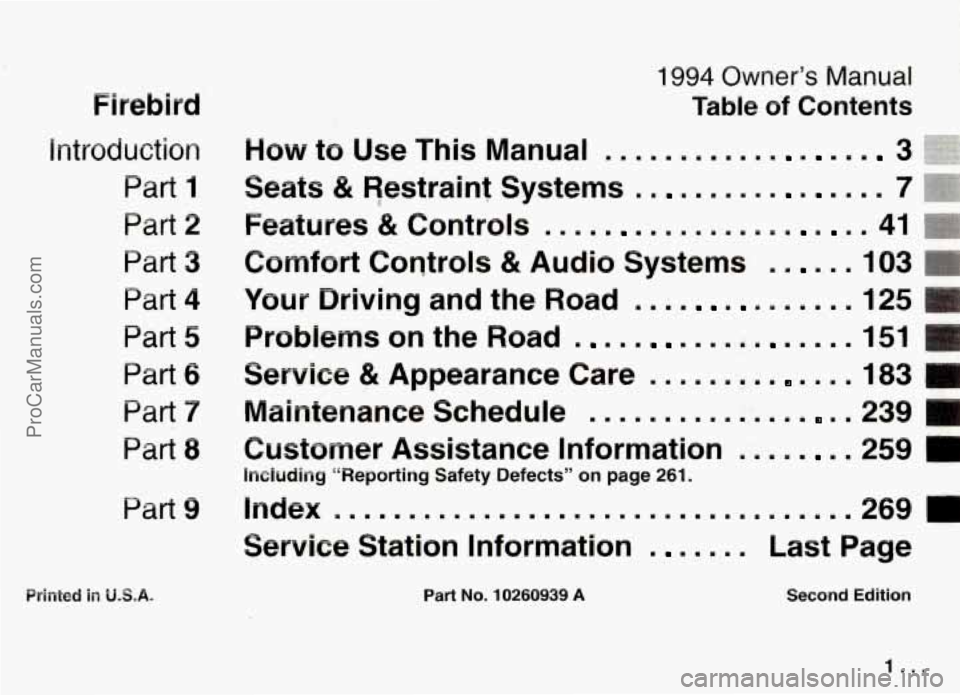
Firebird
1994 0wn:er’s Manual
Table of Contents
Introduction
Part 1
Part 2
Part 3
Part 4
Part 5
Part 6
Part 9
Part 8
Part 9
How to Use This Manual ,, 3
Seats
& Restraint 6 Systems 7
Features & Controls m 41
Comfort Coqtrols
& Audio Systems 103
Your Driving and the
Road m 125
Probiems
on the Road = 151
& Appearance Care m =. 183
Maintenance Schedule
A = 239
Customer Assistance Information
m 259
Including “Reporting Safety Defects” on page 261.
hdeX smmmm=m.====mmmmm==.mm=mmmmm==m=mmm 269
Servi.ce Station Information
Last Page
Printed in U.S.A. Part No. 10260939 A Second Edition
1 ...
ProCarManuals.com
Page 4 of 290
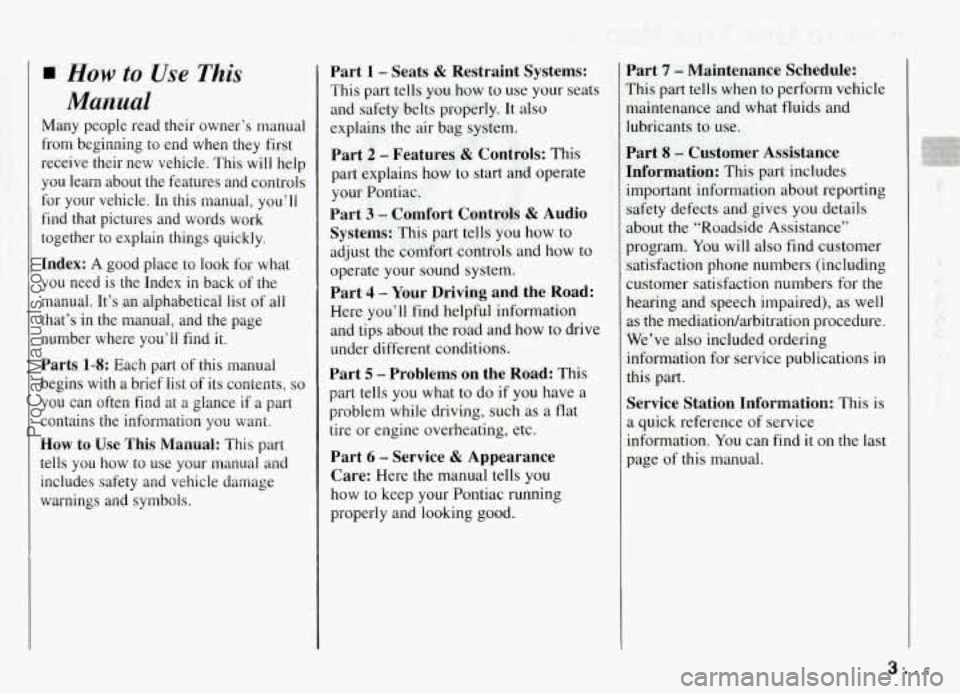
How to Use This
Manual
Many people read their owner’s manual
from beginning to end when they first
receive their new vehicle. This will help you learn about the features and controls
for your vehicle. In this manual, you’ll
find that pictures and words work
together to explain things quickly.
~ Index: A good place to look for what
you need is the Index
in back of the
manual. It’s an alphabetical list of all
that’s in the manual, and the page
number where you’ll find it.
Parts 1-8: Each part of this manual
begins with a brief list of its contents,
so
you can often find at a glance if a part
contains the information you want.
How to Use This Manual: This part
tells you how to use your manual and
includes safety and vehicle damage
warnings and symbols.
Part 1 - Seats & Restraint Systems:
This part tells you how to use your seats
and safety belts properly.
It also
explains the air bag system.
Part 2 - Features & Controls: This
part explains how to start and operate
your Pontiac.
Part 3 - Comfort Controls & Audio
Systems:
This part tells you how to
adjust the comfort controls and how
to
operate your sound system.
Part 4 - Your Driving and the Road:
Here you’ll find helpful information
and tips about the road and how to drive
under different conditions.
Part 5 - Problems on the Road: This
part tells you what to do if you have a
problem while driving, such as a flat
tire or engine overheating, etc.
Part 6 - Service & Appearance
Care:
Here the manual tells you
how to keep your Pontiac running
properly and looking good.
Part 7 - Maintenance Schedule:
This part tells when to perform vehicle
maintenance and what fluids and
lubricants to use.
Part 8 - Customer Assistance
Information:
This part includes
important information about reporting
safety defects and gives
you details
about the “Roadside Assistance” program.
You will also find customer
satisfaction phone numbers (including
customer satisfaction numbers for the
hearing and speech impaired), as well
as the mediatiodarbitration procedure.
We’ve also included ordering
information for service publications in
this part.
Service Station Information: This is
a quick reference of service
information.
You can find it on the last
page of this manual.
3...
ProCarManuals.com
Page 24 of 290

This vehicle has AIR BAGS for front occupants.
A CAUTION: YOU NEED YOUR SAFETY BELT, EVEN WITH AN AIR BAG.
AND HERE’S WHY
Air bags are not designed to inflate in rollovers or in rear, side or low-speed frontal crashes.
Air bags inflate with great force, faster than the blink of an eye. If you’re too close to an inflating
air bag, it could seriously injure you. Safety belts help keep you in position for air bag inflation
in a crash.
An inflating air bag can seriously injure small children. Follow t\
he instructions on the passenger
safety belt Caution label.
REGULAR MAINTENANCE OF THE AIR BAG SYSTEM IS NOT REQUIRED. If the
air bag readiness light comes on while you are driving, or doesn’t come on when you first start
your vehicle, see your dealer for service.
PRINTED IN USA. See your Owner’s Manual for more information. PART NO C20-30-355
Supplemental Inflatable
Restraint System
(Air Bags)
Here are the most important things to
know:
rhis section explains the Supplemental
[nflatable Restraint (SIR), or “air bag,”
system. Your Pontiac has an air bag
For both the driver and the right-front
Jassenger.
23 ...
ProCarManuals.com
Page 28 of 290

Servicing Your Air Bag-Equipped
Pontiac
Air bags affect how your Pontiac should
be serviced. There are parts of the air bag
system
in several places around your
vehicle.
You don’t want the system to
inflate while someone is working on your
vehiele. Your Pontiac dealer and the
1994
Firebird Service Manual have information
about servicing your vehicle and the air
bag system. The air bag system does not
need regular maintenance.
Safety Belt Use during
Pregnancy
Safety belts work for everyone, including
pregnant women. Like all occupants, they
are more likely to be seriously injured if
they don’t wear safety belts.
A pregnant woman should wear a
lap-shoulder belt, and the lap portion
should be worn as low as possible
throughout the pregnancy.
The best way to protect the fetus is to
protect the mother. When a safety belt
is
worn properly, it’s more likely that the
fetus won’t be
hurt in a crash. For
pregnant women, as for anyone, the key
to making safety belts effective is wearing
them properly.
’assenger Positions
tight Front Passenger Position
:he right front passenger’s safety belt
vorks the same way as the driver’s safety
belt. See “Driver Position,” earlier
in this
kart.
27. .
ProCarManuals.com
Page 150 of 290
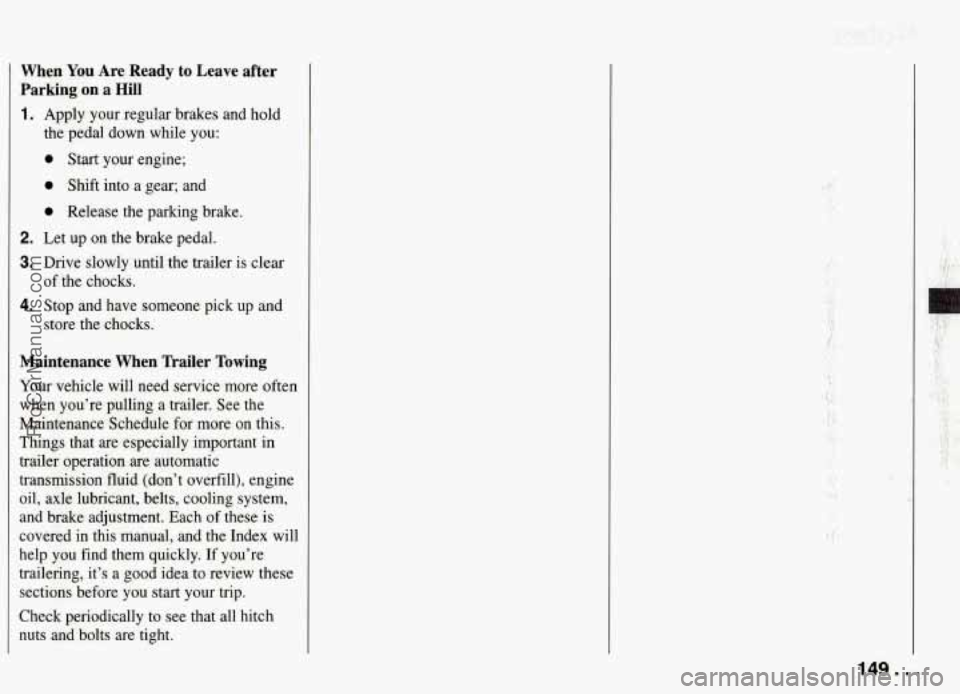
When You Are Ready to Leave after
Parking on a
Hill
1. Apply your regular brakes and hold
the pedal down while you:
0 Start your engine;
0 Shift into a gear; and
0 Release the parking brake.
2. Let up on the brake pedal.
.
3. Drive slowly until the trailer is clear
4. Stop and have someone pick up and
of the chocks.
store the chocks.
Maintenance When Trailer Towing
Your vehicle will need service more often
when you're pulling a trailer. See the
Maintenance Schedule for more on this.
Things that are especially important in
trailer operation are automatic
transmission fluid (don't overfill), engine
oil, axle lubricant, belts, cooling system,
and brake adjustment. Each of these
is
covered in this manual, and the Index will
help you find them quickly. If you're
trailering, it's a good idea to review these
sections before you start your trip.
Check periodically to see that all hitch
nuts and bolts .are tight.
I
I
149.. .
ProCarManuals.com
Page 184 of 290
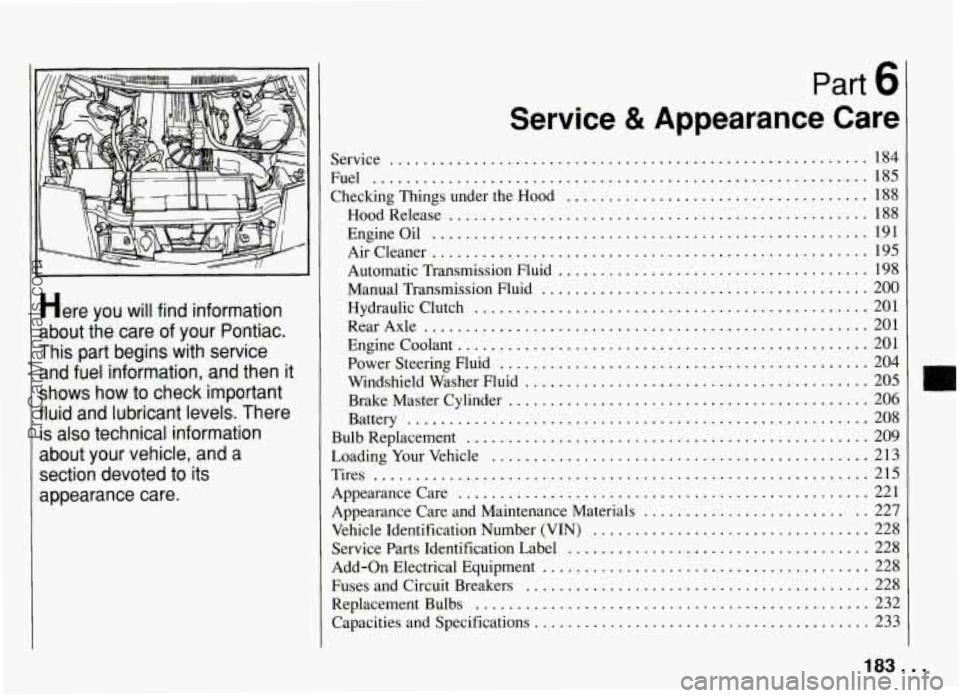
I I
Here you will find information
about the care of your Pontiac
.
This part begins with service and fuel information. and then
it
shows how to check important
fluid and lubricant levels
. There
is also technical information
about your vehicle. and a section devoted
to its
appearance care
.
Part b
Service 8t Appearance Care
Service .........................................................
Fuel ...........................................................
Checking Things under the Hood ....................................
HoodRelease ..................................................
184
185
188
188
Engineoil
.................................................... 191
Aircleaner
.................................................... 195
Automatic Transmission Fluid
..................................... 198
Manual Transmission Fluid
....................................... 200
Hydraulic Clutch
............................................... 201
RearAxle
..................................................... 201
Enginecoolant
................................................. 201
Power Steering fluid
............................................ 204
Windshield Washer Fluid
......................................... 205
Brake Master Cylinder
........................................... 206
Bulb Replacement
................................................ 209
Battery
....................................................... 208
LoadingYourVehicle
............................................. 213
Tires
........................................................... 215
Appearance Care
................................................. 221
Appearance Care and Maintenance Materials
.......................... 227
Vehicle Identification Number (VIN)
................................. 228
Service Parts Identification Label
.................................... 228
Add-on Electrical Equipment
....................................... 228
Fuses and Circuit Breakers
......................................... 228
ReplacementBulbs
............................................... 232
Capacities and Specifications
........................................ 233
183 ...
ProCarManuals.com
Page 185 of 290

Service and Appearance Care
~
Service
Your Pontiac dealer knows your vehicle
best and wants you to be happy with it.
We hope you’ll go to your dealer for all
your service needs. You’ll get genuine
GM parts and GM-trained and supported
service people.
We hope you’ll want to keep your GM
vehicle all GM. Genuine GM parts have
one
of these marks.
Doing Your Own Service Work
[f you want to do some of your own
service work, you’ll want to get the
proper Pontiac Service Manual.
It tells
you much more about how
to service
your Pontiac than this manual can.
To
order the proper service manual, see
“Service Publications” in the Index.
Your vehicle has an air bag system.
Before attempting to
do your own
service work, see “Servicing Your Air
Bag-Equipped Pontiac” in the Index.
You should keep a record with all parts
receipts and list the mileage and the date
of any service work you
perform. See
“Maintenance Record” in the Index.
NOTICE:
If you try to do your own service
work without knowing enough about
it, your vehicle could be damaged.
. . .184
ProCarManuals.com
Page 196 of 290

When to Change Engine Oil:
See if any one of these is true for you:
Most trips are less than 4 miles
0 It’s below freezing outside and most
trips are less than
10 miles ( 16 km).
The engine is at low speed most of
the time (as in door-to-door delivery,
or
in stop-and-go traffic).
(6 km).
You tow a trailer often.
Most trips are through dusty places.
If any one of these is true for your
vehicle, then you need to change your
and filter every
3,000 miles (5 000 km) or
3 months - whichever comes first.
If none of them is true, change the oil
every
7,500 miles (12 500 km) or 12
months
- whichever comes first.
Change the filter at the first oil change
and at every other oil change after that.
Engine Coolant Heater (Engine Block
Heater):
An engine coolant heater can be a big
help if you have to park outside in very
cold weather,
0°F (-18°C) or colder. If
your vehicle has this option, see “Engine Coolant Heater” in the Index.
What to Do with Used Oil:
Did you know that used engine oil
:ontains elements that may be unhealthy
:or your skin and could even cause
:ancer? Don’t let used oil stay on your
;kin for very long. Clean your skin and
lails with soap and water, or a good hand
:leaner. Wash or properly throw away
:lothing or rags containing used engine
il. (See the manufacturer’s warnings
ibout the use and disposal of oil
xoducts.)
Used oil can be a real threat to the
mvironment. If you change your own oil,
)e sure to drain all free-flowing oil from
:he filter before disposal. Don’t ever
jispose of oil by putting it in the trash,
2ouring it on the ground, into sewers, or
into streams or bodies
of water. Instead,
recycle it by taking it to a place that
collects used oil. If you have a problem
properly disposing of your used oil, ask
your dealer, a service station or a local
recycling center for help.
3.4L L32 (Code S
Air Cleaner
iefer to the Maintenance Schedule to
letermine when to replace the air filter.
See “Scheduled Maintenance Services”
In the Index.
t
195 ...
ProCarManuals.com
Page 199 of 290
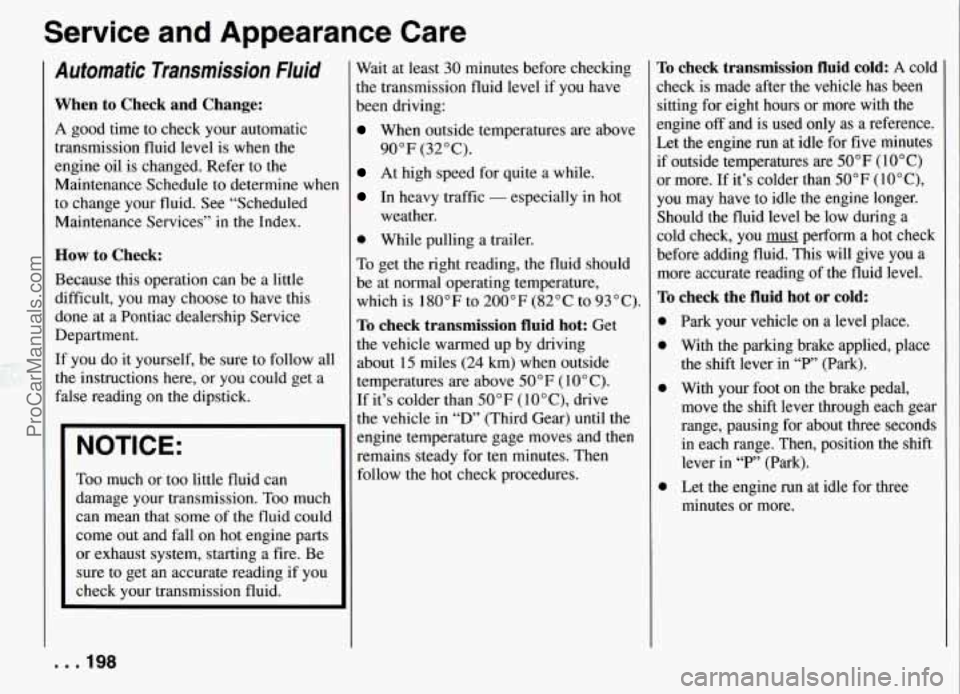
Service and Appearance Care
Automatic Transmission Fluid
When to Check and Change:
A good time to check your automatic
transmission fluid level
is when the
engine oil is changed. Refer to the
Maintenance Schedule to determine when
to change your fluid. See “Scheduled
Maintenance Services” in the Index.
How to Check:
Because this operation can be a little
difficult, you may choose to have this
done at a Pontiac dealership Service
Department.
If you do it yourself, be sure to follow all
the instructions here, or
you could get a
false reading on the dipstick.
Too much or too little fluid can
damage your transmission. Too much
can mean that some of the fluid could
come out and fall on hot engine parts
or exhaust system, starting a fire. Be
sure to get an accurate reading
if you
check your transmission fluid. Wait
at least 30 minutes before checking
the transmission fluid level if you have
been driving:
When outside temperatures are above
At high speed for quite a while.
In heavy traffic - especially in hot
90°F (32°C).
weather.
While pulling a trailer.
To get the right reading, the fluid should
be at normal operating temperature,
which is 180°F to 200°F (82°C to 93°C).
To check transmission fluid hot: Get
the vehicle warmed up by driving
about
15 miles (24 km) when outside
temperatures
are above 50°F ( 10°C).
If it’s colder than 50°F ( lO”C), drive
the vehicle in
“D’ (Third Gear) until the
engine temperature gage moves and then
remains steady for
ten minutes. Then
follow the hot check procedures.
To check transmission fluid cold: A cold
check is made after the vehicle has been
sitting for eight hours or more with the
engine
off and is used only as a reference.
Let the engine run at idle for five minutes
if outside temperatures are 50°F
(10°C)
or more. If it’s colder than 50°F (lO°C),
you may have to idle the engine longer.
Should the fluid level be low during a
cold check, you must perform a hot check
before adding fluid. This will give you a
more accurate reading of the fluid level.
To check the fluid hot or cold:
0
Park your vehicle on a level place.
With the parking brake applied, place
the shift lever
in “P” (Park).
With your foot on the brake pedal,
move the shift lever through each gear
range, pausing for about three seconds
in each range. Then, position the shift
lever in “P” (Park).
Let the engine
run at idle for three
minutes or more.
. . .I98
ProCarManuals.com
Page 200 of 290

3.4L L32 (Code S)
Then, without shutting off the engine,
follow these steps:
1. Pull out the dipstick and wipe it with a
clean rag or paper towel.
1.7L LTI (Code P)
2. Push it back in all the way, wait three
seconds and then pull it back out
again.
3. Check both sides of the dipstick, and
i-ead the lower level. The fluid level
must be in the “COLD” area
for a colc
check
or in the “HOT” area or
cross-hatched area for
a hot check.
4. If the fluid level is in the acceptable
range. push the dipstick back
in all the
way.
How to Add Fluid:
Refer to the Maintenance Schedule to
determine what kind
of transmission fluid
to use. See “Recommended Fluids and
Lubricants”
in the Index.
199 ...
ProCarManuals.com